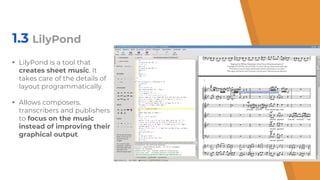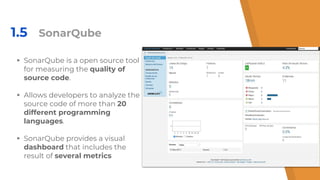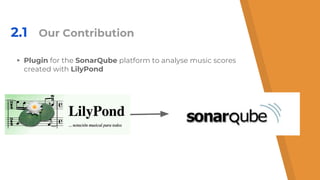Static code analysis to measure the quality of musical scores
- 1. Static code analysis to measure the quality of musical scores Javier Merch├Īn S├Īnchez-Jara Tatiana Person Almudena Mangas-Vega Iv├Īn Ruiz-Rube Juan Manuel Dodero Jose Miguel Mota ICCC 2018
- 2. TABLE OF CONTENTS 1. Context 2. Contribution 3. Evaluation 4. Conclusions and future work
- 3. 1. Context
- 4. Introduction1.1 Ō¢Ė Humanities become digital since the moment in which the search and retrieval of information in the current scenario passes irremediably through the resources on the Web. Musical edition and creation does not escape this situation. Ō¢Ė The required skills to improve this creative cycle depend on using new web resources, enriched with diverse technological, communicative and problem solving issues that form the basis of creative thinking abilities.
- 5. Digital creation of musical scores1.2 Ō¢Ė All the agents that interrelate with a digital score (authors, interpreters, researchers, librarians, repository managers, etc.) need to use software to develop their work. Ō¢Ė In recent years, several tools have been developed to create, study and share musical scores. Ō¢Ė Any failure in the quality of the digital documents (scores) can be replicated and spreaded when sharing them on the Internet. Ō¢Ė It is necessary to apply quality controls to check musical artifacts and find potential issues. However, this may be a time-consuming and (probably) unsustainable task, especially, in large repositories.
- 6. LilyPond1.3 Ō¢Ė LilyPond is a tool that creates sheet music. It takes care of the details of layout programmatically. Ō¢Ė Allows composers, transcribers and publishers to focus on the music instead of improving their graphical output.
- 7. Ō¢Ė In Software Engineering, static analysis is one of common techniques to ensure the quality of the programs. Ō¢Ė This is a white-box testing technique consisting on scanning the source code (line by line) prior to release or sell the software. Ō¢Ė The aim is to find common issues, such as duplicated statements, code blocks with high complexity, security vulnerabilities, potential bugs, etc. Ō¢Ė Luckily, there are tools for automating code analysis Code static analysis1.4
- 8. Ō¢Ė SonarQube is a open source tool for measuring the quality of source code. Ō¢Ė Allows developers to analyze the source code of more than 20 different programming languages. Ō¢Ė SonarQube provides a visual dashboard that includes the result of several metrics SonarQube1.5
- 10. Ō¢Ė Plugin for the SonarQube platform to analyse music scores created with LilyPond Our Contribution2.1
- 11. Implemented rules to check music scores2.2 Ō¢Ė Rule 1: Check that not use is made of consecutive silent beats. Ō¢Ė Rule 2: Check if a note is held in the previous beat for include a precautionary alteration. Ō¢Ė Rule 3: Check that the tempo has been included at the beginning of the music score. Ō¢Ė Rule 4: Check that the time change has been done correctly. Ō¢Ė Rule 5: Check that the music sheet title is included.
- 12. Implemented rules to check music scores (2)2.2 Ō¢Ė Rule 6: Check that the music sheet composer is included. Ō¢Ė Rule 7: Check that a page step cannot exist in a repeat volta instruction. Ō¢Ė Rule 8: Check that the lines of code should not be too long.
- 13. SonarQube definitions2.3 Ō¢Ė Error: Message displayed by SonarQube describing the reason for the error. Ō¢Ė Severity: Severity level of the error. SonarQube categorizes errors in "Minor" or "Major" severity, depending on the relevance and correction time of the error. Ō¢Ė Time: The estimated time that the creator of the musical score must spend to correct the error.
- 14. Quality rules2.4
- 15. 3. Evaluation
- 16. Evaluation process3.1 Ō¢Ė A study of usability was conducted on a set of experts in the music domain Ō¢Ė First, the respondents had to directly observe a given sheet music in PDF. This music score was created using LilyPond including some syntax errors. Ō¢Ė Afterwards, the experts had to access to the SonarQube instance and then visualise the list of evidences automatically found in the sheet Ō¢Ė Finally, the have to fill in a pre-test and a post-test questionnaire
- 17. Music sheet PDF created with LilyPond3.2 https://goo.gl/CLc54N
- 18. Analysing music sheet in SonarQube3.3 http://vedilsanalytics.uca.es/sonarqube/dashboard/index/35
- 19. Analysing music sheet in SonarQube (2)3.3 http://vedilsanalytics.uca.es/sonarqube/dashboard/index/35
- 20. Usability attributes3.4 Ō¢Ė Learnability: Have you been able to access to SonarQube and visualise the errors and bad practices automatically found by the tool for the sheet music created with LilyPond? Ō¢Ė Efficiency: Do you think that the errors and warnings issued by SonarQube correspond to the ones you found when you observed the sheet music in PDF? Ō¢Ė Satisfaction: Would you consider interesting the inclusion of this type of tool to analyse the quality of music sheets? Ō¢Ė Utility: How useful would you consider this tool?
- 21. Results3.5
- 23. Conclusions and future work 4.1 Ō¢Ė An extension to the static analysis code platform SonarQube to measure the quality of musical scores created with LilyPond. Ō¢Ė The work is limited to the implementation of a very specific set of metrics, aimed at experimentation and preliminary evaluation of its usefulness by a panel of experts. Ō¢Ė As future work, we will expand the collection of metrics. In addition, we'll improve the plugin to analyse scores created with other tools besides LilyPond (v.g. MuseScore). Ō¢Ė Another domain that is interesting to consider is to detect and evaluate the incorporation of additional contextual information to the score, including bibliographic information, as well as descriptive or interpretive information whose presence is not an essential requirement but an added value regarding quality.
- 24. THANKS! You can find me at ivan.ruiz@uca.es
























